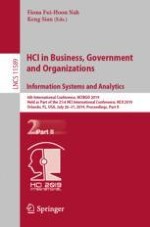2019 | Buch
HCI in Business, Government and Organizations. Information Systems and Analytics
6th International Conference, HCIBGO 2019, Held as Part of the 21st HCI International Conference, HCII 2019, Orlando, FL, USA, July 26-31, 2019, Proceedings, Part II
herausgegeben von: Dr. Fiona Fui-Hoon Nah, Prof. Keng Siau
Verlag: Springer International Publishing
Buchreihe : Lecture Notes in Computer Science
